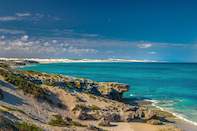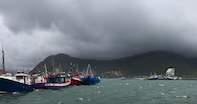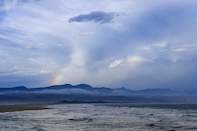An important factor in determining the climate and indeed in learning how to 'read' the weather of the Western Cape, is the wind. Once you tune into the changing wind patterns and what they mean in terms of oncoming conditions, you will be well prepared.

A Mediterranean Climate
The prevailing wind in summer is south-southeast, while that in winter is northwest, and brings rain. Occasionally in winter, one may also get what is known as a 'black southeaster', which also brings rain.
Climate is the average weather pattern over a long period (a few decades), whereas weather is the actual atmospheric conditions at a particular time and place. So, while the Western Cape Climate has a hot and dry summer climate, you could well find yourself standing in the mountains in cold and blustery weather in mid-December.
The pattern of hot, dry summers and temperate, wet winters that we experience with the Western Cape Climate is known as a Mediterranean climate.
Other places that have a similar climate are, naturally enough, the Mediterranean coastal areas, as well as south-western Australia, northwestern Chile and southwestern California.
These places also share the same macchia-type vegetation that here we call 'fynbos'. An interesting point about the vegetation in these areas is that, while the plants of these regions all look very much the same, they share very few common species, genera or even families; they have evolved such similar forms and functions due to corresponding environmental conditions.
Cape Seasons and Hiking

The Western Cape Climate summer southeaster comes off the South Atlantic High Pressure System, which builds to its maximum strength around November and then slacks off towards February. But, year by year, the relative strengths of these two major systems can vary greatly, and it is not unknown to have black southeasters bringing squalls to the Peninsula and snowfalls on the Boland mountains around Christmas time.
Likewise, between the swathes of cold fronts in winter, the weather can clear for a few days at a time, giving beautifully clear and warm weather.
Spring and Autumn are the best times for hiking, for the weather is mostly even and kind. I have hiked in the Langeberg in spring, once in soaking conditions and once in snow, and yet again in the most glorious conditions that I have known anywhere. There is certainly an element of luck when planning a hiking trip but my advice is this: the best months are March to May and September to November. Not only is the weather at its best, but so is the vegetation.
If the weather turns bad over your planned period, just take warm and rainproof clothes and go, as poor weather usually alternates with good conditions, possibly more than once in the same day. These conditions can prove most exciting - not to mention the fantastic photographic opportunities provided by the dramatic and changing light conditions.
Cold Fronts

Most people presume the cold fronts that pummel the Cape throughout winter originate in the Antarctic, but the real picture is somewhat more complicated. The cold winds start with a high energy build up over the Pacific Ocean off the coast of Peru and Ecuador.
The resultant warm air rises and is blown eastwards until it is forced up against the Andes, and then pushed right into the upper atmosphere. Here it is chilled and descends due to increased density, becoming a low pressure cell.
It is then deflected southwards by the earth's rotation, touches down in the region of the Falkland Islands, and is again deflected, this time up to the northwest. The cell passes Gough and Marion islands before reaching the Cape.
As it passes we can detect it in a barometer, which rises for a high pressure cell, and drops for a low pressure one (which, in everyday parlance, is called a 'cold front'). After passing the Cape, the cell turns off the east coast of Africa and sweeps up past the west coast of Australia, eventually moving past northern Australia towards Japan.
Typical Winter in the Western Cape

In winter, the cold fronts tend to hit us at an average rate of one every six days, causing the weather of the Western Cape to approximately follow this pattern:
Day 1: Southeast winds prevail with accompanying high pressure.
Day 2: Low pressure cell moves in, and wind backs up to the northeast bringing dry warm berg winds.
Day 3: Wind backs up anti-clockwise to the northwest with cirrus clouds heralding the cold front.
Day 4: Wind backs up again, this time to the southwest, bringing colder air and possibility of snow.
Day 5: High pressure cell approaches and weather begins to clear.
Day 6: Southwest winds prevail. It is the backing up of the wind direction, and the cloud formations, that you should be aware of, in order to predict the weather.
 Self drive routes from Cape Town invite visitors to the Mother City to experience the natural splendour, fun activities and scenic attractio...
Self drive routes from Cape Town invite visitors to the Mother City to experience the natural splendour, fun activities and scenic attractio... If you’re in search of the perfect blend of adventure, leisure and culture, the Western Cape is your Holy Grail of African travel. From th...
If you’re in search of the perfect blend of adventure, leisure and culture, the Western Cape is your Holy Grail of African travel. From th...